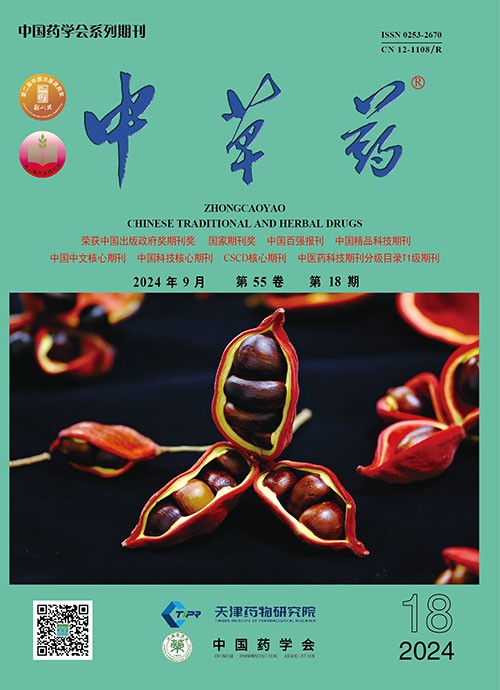基于数据驱动分析的抗病毒中药分布规律
Q3 Pharmacology, Toxicology and Pharmaceutics
引用次数: 0
摘要
目的:挖掘抗病毒中药的分布规律,为当前疫情防控中筛选抗病毒中药及候选方剂提供依据。方法:以《中药抗病毒研究与应用》和中国知网、Web of science上的抗病毒中药文献报道为信息源,对相关信息进行规范化,采用频次分析、共现分析和系统发育树构建方法,挖掘抗病毒中药的药性、科属、有效成分和活性的分布规律。结果:共筛选到511种抗病毒中药,在冠状病毒病2019 (COVID-19)“三药三方”涉及的48种中草药中含有41种。多具有性寒、味苦、回肺肝经等药性,其中百兰根(板蓝根)、黄芩(黄芩)、金银花(金银花)最为常见。冠状病毒科资料135份,高频中药为柴胡、甘草和板蓝根。同时,2003年SARS期间研究最多的中药是板蓝根和苦豆子,而2020年突然发生COVID-19时,研究最多的中药是桑白皮。中药抗病毒的有效成分主要是多糖和黄酮类化合物。具有抗病毒作用的中药共涉及564个基源种,在系统发育树上具有显著的聚类性,主要分布在种子植物门的菊花和玫瑰枝上,其中具有抗病毒作用的中药以菊科、唇科、豆科和蔷薇科最多。结论:具有抗病毒作用的中药属性以苦、寒、肺、肝经为主。来自菊科、唇科和豆科的中药更有可能具有抗病毒作用。其有效成分黄芪多糖、板蓝根多糖、槲皮素、咖啡酸、熊果酸等均为多糖或黄酮类化合物,这些规律与本次抗击疫情中推广使用的“三药三方”基本一致。本研究为中药抗病毒活性的筛选,特别是为当前新型冠状病毒肺炎防控候选中药的筛选提供参考。本文章由计算机程序翻译,如有差异,请以英文原文为准。
Distribution rules of antiviral traditional Chinese medicine based on data driven analysis
Objective: To mine the distribution rules of antiviral traditional Chinese medicine (TCM), in order to provide the basis for the screening of antiviral activity of TCM and candidate prescriptions for current epidemic prevention and control. Methods: Taking the Research and Application of Antiviral Chinese Herbal Medicine and the literature reports of antiviral TCM in CNKI and Web of science as information sources, the relevant information was standardized, and the distribution rules of medicinal properties, families and genera, active ingredients and activity of antiviral TCM were mined by frequency analysis, co-occurrence analysis and phylogenetic tree construction methods. Results: A total of 511 antiviral TCM were screened, containing 41 of the 48 herbs involved in the "three medicines and three prescriptions" of coronavirus disease 2019 (COVID-19). Mostly with medicinal properties such as cold nature, bitter taste, return to the lung and liver meridian, among which Bailangen (Isatidis Radix), Huangqin (Scutellariae Radix), and Jinyinhua (Lonicerae Japonicae Flos) were the most common. The data of coronaviridae was 135, and the high-frequency TCM were Chaihu (Bupleuri Radix), Gancao (Glycyrrhizae Radix et Rhizoma), and Isatidis Radix. Meanwhile, it was found that Isatidis Radix and Kudouzi (the seed of Sophora alopecuroides) were the most studied TCM during the SARS period in 2003, while in 2020, the research on Sangbaipi (Mori Cortex) was the first when COVID-19 was sudden. The effective ingredients of antiviral TCM were mostly polysaccharides and flavonoids. TCM with antiviral effects involved a total of 564 base source species, which had significant clustering on phylogenetic trees and were mainly distributed in the chrysanthemum and rose branches of the seed plant phylum, with Asteraceae, Labiatae, Leguminosae, and Rosaceae having the most antiviral TCM. Conclusion: These results suggested that the attributes of TCM with antiviral effects are mainly bitter, cold, lung and liver meridian. TCM origin from Asteraceae, Labiatae, and Leguminosae are more likely to have antiviral effects. Their effective components such as astragalus polysaccharide, Isatidis Radix polysaccharide, quercetin, caffeic acid and ursolic acid are polysaccharides or flavonoids, and these rules are basically consistent with the "three medicines and three prescriptions" promoted and used in this fight against the COVID-19 epidemic. This study provides a reference for the screening of antiviral TCM activity, especially for the screening of candidate TCM for the prevention and control of the current COVID-19.
求助全文
通过发布文献求助,成功后即可免费获取论文全文。
去求助
来源期刊

中草药杂志
Pharmacology, Toxicology and Pharmaceutics-Pharmaceutical Science
CiteScore
1.10
自引率
0.00%
发文量
23538
期刊介绍:
hinese Traditional and Herbal Drugs, a monthly journal with “zhongcaoyao” as Chinese name, the initial issue was distributed in January, 1970 and its ISSN is 0253-2670. The journal is an academic and technical journal sponsored by Chinese Pharmaceutical Association and Tianjin Institute of Pharmaceutical Research (TIPR). The journal, which has a long history of 41 years, offers the columns of research papers, brief reports, reviews, dissertation, and special treatises to report the recent achievements of our basic study, production, quality control, and clinic application on traditional Chinese medicine and Chinese materia medica. The editorial committee consists of over one hundred of specialists with a great academic attainment in pharmaceutical research, education, production, quality control, and clinic application.
 求助内容:
求助内容: 应助结果提醒方式:
应助结果提醒方式:


